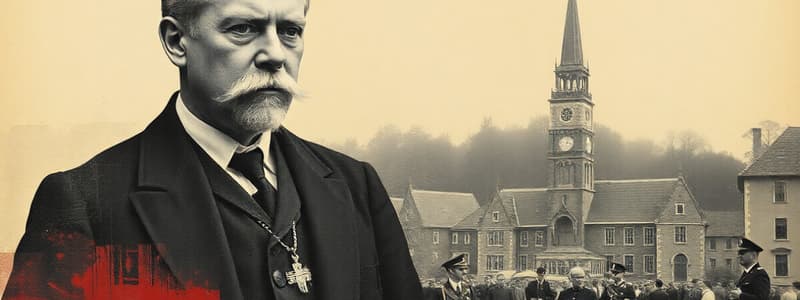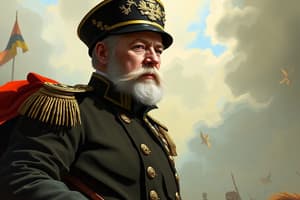Podcast
Questions and Answers
Explain the key difference in the approach to German unification between Otto von Bismarck and the liberals in the Prussian Parliament.
Explain the key difference in the approach to German unification between Otto von Bismarck and the liberals in the Prussian Parliament.
Bismarck advocated for unification through military strength and war ('blood and iron'), while the liberals preferred achieving it through negotiations, especially with Austria.
What were the main motivations behind the Pan-Slavic movement, and which major empires did it challenge?
What were the main motivations behind the Pan-Slavic movement, and which major empires did it challenge?
The Pan-Slavic movement aimed to unify all Slavic peoples under a single political entity, challenging the authority and control of Austria, Germany, and the Ottoman Empire.
Describe how Bismarck strategically used wars to achieve German unification, naming the two major conflicts he instigated.
Describe how Bismarck strategically used wars to achieve German unification, naming the two major conflicts he instigated.
Bismarck instigated wars against Austria (the Seven Weeks' War) to exclude Austrian influence from Germany, and manipulated France into starting the Franco-Prussian War to unite the remaining German states against a common enemy.
Explain how the creation of the Dual Monarchy of Austria-Hungary addressed Hungarian nationalism and what impact did it have on other ethnic groups within the Habsburg Empire?
Explain how the creation of the Dual Monarchy of Austria-Hungary addressed Hungarian nationalism and what impact did it have on other ethnic groups within the Habsburg Empire?
How did the weakness of the Ottoman Empire contribute to the rise of nationalist movements in the Balkans during the late 19th century?
How did the weakness of the Ottoman Empire contribute to the rise of nationalist movements in the Balkans during the late 19th century?
Flashcards
Holy Roman Empire (HRE)
Holy Roman Empire (HRE)
A multi-ethnic political region, consisting of hundreds of smaller states with Germany at its heart.
Otto von Bismarck
Otto von Bismarck
Minister-President of Prussia who unified the German states through military and political strategies, ignoring parliament.
Pan-Slavic Movement
Pan-Slavic Movement
A political movement aiming to unify all Slavic peoples under a single political entity, often under Russia's protection.
Dual Monarchy of Austria-Hungary
Dual Monarchy of Austria-Hungary
Signup and view all the flashcards
Ferenc Deak's Compromise
Ferenc Deak's Compromise
Signup and view all the flashcards
Study Notes
- For almost a thousand years, Germany was at the center of the Holy Roman Empire, a multi-ethnic political entity comprised of hundreds of smaller states.
- In 1815, the European powers formed a confederation to unite German-speaking states while limiting the power of Prussia and the Austrian Empire, balancing them against each other.
- King Wilhelm I of Prussia aimed to unify the German states under Prussian rule, facing opposition from Parliament.
- Wilhelm I appointed Otto von Bismarck as Minister-President, who ignored Parliament and expanded/reformed the military, consolidating the king's control.
- Both conservatives and liberals in Prussia were nationalists who desired a unified German nation-state.
- Bismarck believed Prussia's borders would be secured "by blood and iron," rather than speeches.
- Bismarck sought a Germany free of Austrian influence, necessitating war.
- Prussia attacked Austria and achieved a swift victory in just seven weeks.
- Bismarck needed another war against France to create a unified Germany.
- Bismarck tricked France into starting the war; the Prussian army quickly defeated the French in four weeks, leading to the collapse of the Second French Empire.
- In 1875, Slavic peoples in Ottoman Bosnia and Herzegovina rebelled against the Ottomans to gain freedom.
- The Ottomans' weakness led Montenegro and Serbia to aid the rebellion.
- Within a year, the rebellion spread to the Ottoman province of Bulgaria.
- This rebellion was part of the Pan-Slavic movement, aiming to unite all Slavic peoples—many under Austrian, German, and Ottoman control—under Russia's protection.
- Russia, seeking to conquer the Ottomans, allied with the rebels, Serbia, and Montenegro, and declared war against the Ottomans.
Habsburg Empire
- The Habsburgs ruled a multinational empire of 50 million people.
- Less than a quarter of the population were German-speaking Austrians.
- Almost half were Slavic groups including Czechs, Slovaks, Poles, Ukrainians, Serbs, Croats, and Slovenes.
- The empire also included large numbers of Hungarians.
- The government crushed nationalist revolts.
- Franz Joseph inherited the Habsburg throne amid turmoil and sought to strengthen the empire.
- Ferenc Deak, a Hungarian leader, helped create the Dual Monarchy of Austria-Hungary.
- Under this compromise, Austria and Hungary became separate states ruled by Franz Joseph as emperor of Austria and king of Hungary.
- Hungarians welcomed the compromise, but other groups resented it.
- Restlessness increased among various Slavic groups.
- Some nationalist leaders called on Slavs to unite.
Studying That Suits You
Use AI to generate personalized quizzes and flashcards to suit your learning preferences.




